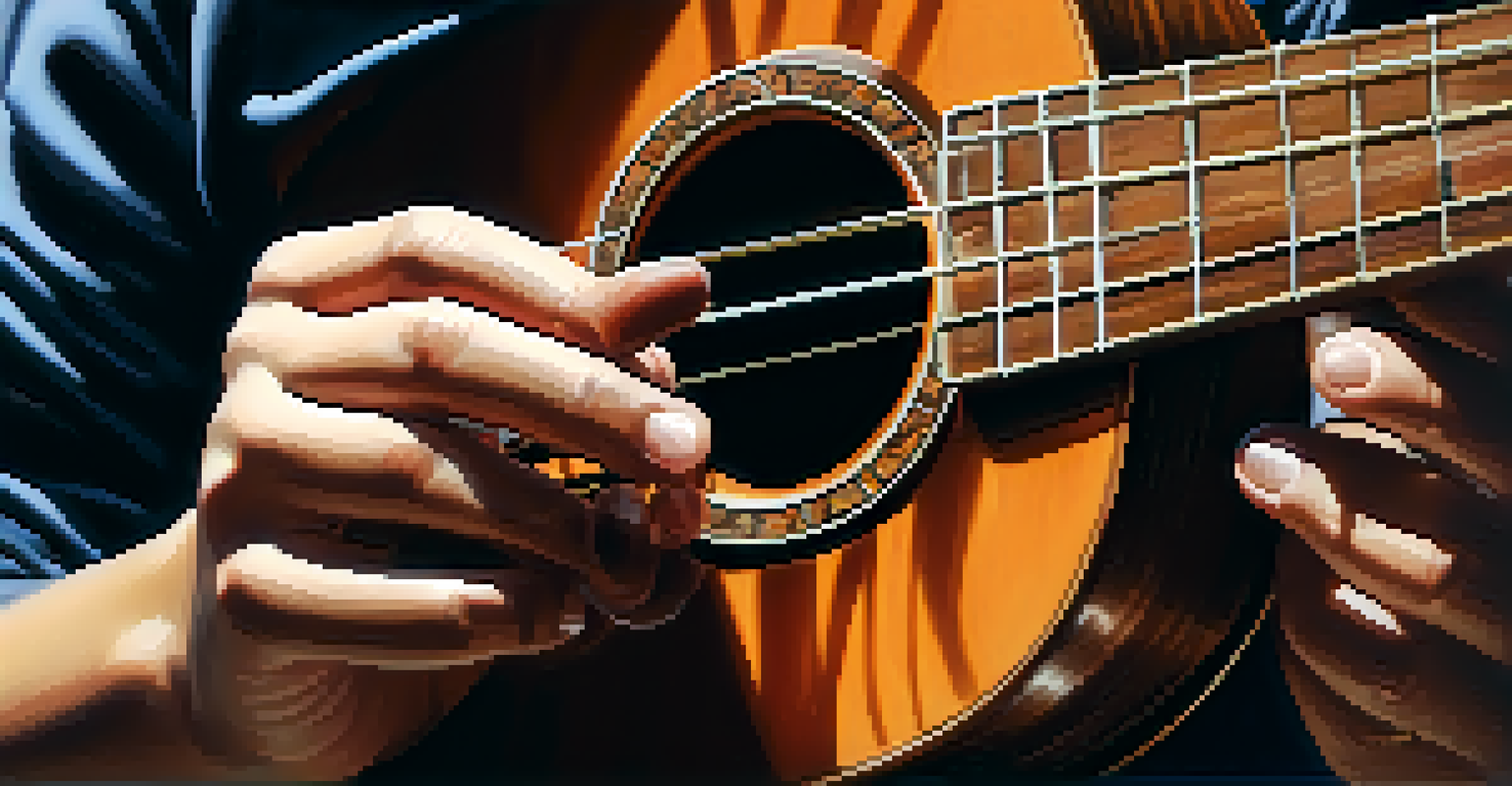The Unique Chord Progressions Enabled by the Ukulele

The Basics: Understanding Ukulele Chord Structures
Before diving into unique chord progressions, it’s essential to understand the basic chord structures of the ukulele. Unlike the guitar, which has six strings, the ukulele features only four, typically tuned to G-C-E-A. This tuning allows for a variety of chords that can easily be played with just a few finger placements. As you grasp these basics, you’ll start to see how the ukulele invites creativity.
Music is the shorthand of emotion.
For instance, the standard C major chord is a staple for many beginners, as it only requires one finger. However, the magic begins when you start experimenting with variations, such as Cmaj7 or C6, which add depth and complexity to your music. The simplicity of the instrument allows for quick exploration of these variations, making it an ideal choice for those new to music.
Ultimately, understanding these foundational chords is the first step toward creating your unique sound. As you become familiar with the chord structures, you’ll find opportunities to incorporate them into your progressions, setting the stage for memorable musical moments.
Why the Ukulele Inspires Unique Progressions
The ukulele's distinct sound and compact size create a unique musical canvas for composers and performers alike. Its bright, cheerful tone instantly lifts the mood, making it a perfect instrument for exploring unconventional progressions. Unlike traditional guitars that often lend themselves to standard patterns, the ukulele encourages players to think outside the box.

One reason for this is the ease of finger movement on the smaller fretboard. You can quickly shift from one chord to another, allowing for spontaneous experimentation. This freedom often leads to unexpected chord sequences that resonate emotionally, creating a delightful blend of harmony and rhythm.
Foundation of Ukulele Chords
Understanding basic ukulele chords, like C major, is crucial for creating your unique sound and exploring musical possibilities.
Moreover, the ukulele's cultural associations—ranging from Hawaiian music to indie pop—further inspire unique progressions that might not be as common in other genres. When you strum the ukulele, you tap into a vibrant world of musical possibilities that invites creativity and innovation.
Exploring Common Ukulele Chord Progressions
Several chord progressions have become staples in ukulele music, offering a fantastic starting point for beginners and seasoned players alike. One of the most popular is the I-IV-V progression, which consists of the C, F, and G chords. This simple yet effective sequence is the backbone of countless songs across various genres, showcasing the versatility of the ukulele.
The beautiful thing about learning is that no one can take it away from you.
Another favorite is the I-V-vi-IV progression, found in many pop hits. In the key of C, this would be C-G-Am-F. This particular sequence creates an emotional resonance, making it a go-to for songwriters looking to connect with their audience. The beauty of these progressions lies in their ability to evoke feelings while remaining easy to play.
By mastering these common progressions, you’ll not only build a solid foundation but also gain the confidence to start exploring your unique creations. Each strum opens the door to new melodies, inviting you to experiment with variations that reflect your personal style.
Experimenting with Alternate Tunings
One of the fascinating aspects of the ukulele is the option to experiment with alternate tunings. While G-C-E-A is the standard tuning, variations like D-G-B-E or A-D-F#-B can yield unexpected and captivating results. By changing the tuning, you can transform familiar chords into entirely new sounds, breathing fresh life into your music.
For example, tuning your ukulele to D-G-B-E allows you to explore jazzier chords that can add a sophisticated flair to your strumming. This flexibility means that even seasoned players can find new inspiration by simply detuning their instrument. It opens up a world of sonic possibilities that can lead to unique progressions you might not have considered otherwise.
Rhythm Enhances Progressions
Experimenting with different strumming patterns and rhythms can transform simple chord progressions into engaging musical experiences.
Experimenting with alternate tunings not only enhances your creativity but also challenges your ear. You’ll start recognizing how different notes interact, leading to a richer understanding of music theory and composition. This exploration can ultimately deepen your appreciation for the ukulele as a versatile instrument.
The Role of Rhythm in Chord Progressions
Rhythm plays a crucial role in shaping how chord progressions are perceived, especially on the ukulele. The instrument’s percussive nature allows you to experiment with strumming patterns that can transform even the simplest chords into something extraordinary. By syncing your strumming with different rhythms, you can create an engaging musical experience.
For instance, a simple down-up strumming pattern can give a lighthearted feel, while using syncopation can add complexity and intrigue. This rhythmic variation is vital in making a progression stand out, allowing you to express different emotions through your playing. The ukulele's bright sound can enhance these rhythmic choices, making your music even more lively.
Moreover, incorporating fingerpicking techniques can completely change the vibe of a progression. By plucking individual strings, you can create a softer, more melodic sound that invites listeners to lean in closer. The versatility of the ukulele allows for endless exploration of rhythm, making it an exciting instrument for both beginner and advanced musicians.
Combining Chords with Melody for Impact
Creating unique chord progressions is just one part of the musical storytelling process; combining these chords with melody is where the real magic happens. The ukulele's light, airy tone makes it an excellent companion for crafting memorable melodies that complement your progressions. By layering melodies on top of chords, you can evoke emotions and engage listeners more deeply.
For instance, consider strumming a simple chord progression while humming or singing a melody that contrasts with the chords themselves. This interplay creates a dynamic listening experience, where the tension and release can captivate your audience. The ukulele’s bright timbre lends itself beautifully to this combination, making your music feel vibrant and alive.
Combine Chords with Melody
Layering melodies over chords allows for dynamic storytelling in music, enhancing emotional engagement with listeners.
Additionally, experimenting with different melodic structures—such as arpeggios or runs—can further enhance your compositions. The combination of intricate melodies over rich chord progressions can lead to powerful musical moments, allowing you to express your unique voice as a musician.
Final Thoughts: Embrace Your Ukulele Journey
As you explore the unique chord progressions enabled by the ukulele, remember that the journey is just as important as the destination. Each strum, each chord change, and each new progression you discover is a step toward finding your musical identity. The ukulele, with its approachable nature, encourages experimentation and creativity, making it an ideal instrument for self-expression.
Don’t be afraid to step outside your comfort zone. Try alternative tunings, mix up your strumming patterns, or even incorporate unexpected rhythms. The beauty of the ukulele lies in its ability to adapt to your personal style, allowing you to create music that resonates with you and your audience.

Ultimately, the key is to enjoy the process. Whether you’re writing your first song or refining your skills, embrace the unique possibilities that the ukulele offers. With a little practice and a lot of heart, you’ll be amazed at the unique chord progressions you can create.